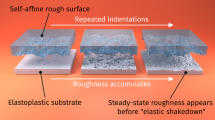Abstract.
We study the elastic properties of a two-dimensional fluctuating surface whose area density is allowed to deviate from its optimal (Schulman) value. The behavior of such a surface is determined by an interplay between the area-dependent elastic energy, the curvature elasticity, and the entropy. We identify three different elastic regimes depending on the ratio \(A_{\rm p}/A_{\rm s}\) between the projected (frame) and the saturated areas. We show that thermal fluctuations modify the elastic energy of stretched surfaces (\(A_{\rm p}/A_{\rm s} > 1\)), and dominate the elastic energy of compressed surfaces (\(A_{\rm p}/A_{\rm s} < 1\)). When \(A_{\rm p}\sim A_{\rm s}\) the elastic energy is not much affected by the fluctuations; the frame area at which the surface tension vanishes becomes smaller than \(A_{\rm s}\) and the area elasticity modulus increases.
Similar content being viewed by others
References
M.J. Rosen, Surfactants and Interfacial Phenomena\/ (Wiley, New York, 1978).
P.G. De Gennes, C. Taupin, J. Phys. Chem. 86, 2294 (1982).
F. David, S. Leibler, J. Phys. II 1, 959 (1991).
U. Seifert, Adv. Phys. 46, 13 (1997) and references therein.
W. Helfrich, Z. Naturforsch. A 33, 305 (1978).
The term “surface” is used in this paper to describe a variety of quasi-two-dimensional systems including simple interfaces, Langmuir monolayers, and self-assembled bilayer membranes.
R. Lipowsky, E. Sackmann (Editors), Structure and Dynamics of Membranes (Elsevier, Amsterdam, 1995).
J. Israelachvili, Intermolecular and Surface Forces\/ (Academic Press, London, 1985).
W.C. Wimley, T.E. Thomson, Biochemistry 30, 1702 (1991).
A. Ben-Shaul, in ref. [7], and references therein.
E. Evans, W. Rawicz, Phys. Rev. Lett. 64, 2094 (1990).
J.H. Schulman, J.B. Montagne, Ann. N. Y. Acad. Sci. 92, 366 (1961).
J.S. Rowlinson, B. Widom, Molecular Theory of Capillarity\/ (Clarendon Press, Oxford, 1982).
The other state variables include the temperature, the number of surface molecules (first model) or the chemical potential (second model), and the volume of the bulk phases. Other ensembles, in which different sets of state variables are used, are also possible. See discussion in Y. Zhang, S.E. Feller, B.R. Brooks, R.W. Pastor, J. Chem. Phys. 103, 10252 (1995).
U. Seifert, Z. Phys. B 97, 299 (1995)
M. Wortis, M. Jarić, U. Seifert, J. Mol. Liq. 71, 195 (1997).
S.T. Milner, S.A. Safran, Phys. Rev. A 36, 4371 (1987).
F. Brochard, P.G. De Gennes, P. Pfeuty, J. Phys. (Paris) 37, 1099 (1976).
D. Marsh, Biophys. J. 73, 865 (1997).
W. Helfrich, R.M. Servuss, Nuovo Cimento D 3, 137 (1984).
W. Cai, T.C. Lubensky, P. Nelson, T. Powers, J. Phys. II 4, 931 (1994).
D.C. Morse, S.T. Milner, Phys. Rev. E 52, 5918 (1995).
S.E. Feller, R.W. Pastor, Biophys. J. 71, 1350 (1996) and references therein.
J.B. Fournier, A. Ajdari, L. Peliti, Phys. Rev. Lett. 86, 4970 (2001).
U. Seifert, R. Lipowsky, in ref. [7] and references therein.
There exist numerous articles summarizing the recent developments in computer simulations of molecular interfaces and bilayer systems, and including many relevant references. See, e.g., J.C. Shelley, M.Y. Shelley, Curr. Opin. Coll. Interface Sci. 5, 101 (2000)
O. Farago, P. Pincus, cond-mat/0307213, submitted to J. Chem. Phys.
In ref. [21] the authors derive the relation \(r=F/A_{\rm p}\) which is correct only for incompressible surfaces. In ref. [27] this result is discussed in the context of compressible surfaces, and it is demonstrated that the correct form (which applies for both compressible and incompressible surfaces) should be \(r= {\rm d} F/{\rm d} A_{\rm p}\).
Since the Monge representation describes the conformation of the surface using a single-valued height function, it excludes configurations in which the surface forms overhangs. In addition to this approximation we also assume that the height function has a moderate slope (see Eqs. (7) and (8)).
P.B. Canham, J. Theor. Biol. 26, 61 (1970).
W. Helfrich, Z. Naturforsch. C 28, 693 (1973).
The expression for the curvature energy in equation (thehamiltonian) is the leading term in an expansion of the elastic energy for small curvatures.
S.A. Safran, Statistical Thermodynamics of Surfaces, Interfaces, and Membranes\/ (Addison-Wesley, New York, 1994).
L. Peliti, S. Leibler, Phys. Rev. Lett. 54, 1690 (1985).
The quantities h q and u q appearing in equations (fourier) and ( meansquare), respectively, are proportional to each other. They both describe the amplitudes of the modes in the Fourier transform of \(h(\vec{r}\,)\), but using different units. The former is dimensionless while the latter has the dimensions of length.
E.M. Blokhuis, D. Bedeaux, Physica A 184, 42 (1992).
O. Farago, J. Chem. Phys. 119, 596 (2003).
R. Goetz, R. Lipowsky, J. Chem. Phys. 108, 7397 (1998).
S.J. Marrink, A.E. Mark, J. Phys. Chem. B 105, 6122 (2001).
S.T. Milner, J.-F. Joanny, P. Pincus, Europhys. Lett. 9, 495 (1989).
J.D. Litster, Phys. Lett. A 53, 193 (1975).
R. Netz, M. Schick, Phys. Rev. E 53, 3875 (1996).
M. Müller, M. Schick, J. Chem. Phys. 105, 8282 (1996).
P. Sens, S.A. Safran, Europhys. Lett. 43, 95 (1998).
J.C. Schillcock, D.H. Boal, Biophys. J. 71, 317 (1996)
Author information
Authors and Affiliations
Corresponding author
Additional information
Received: 14 July 2002, Published online: 19 August 2003
PACS:
87.16.Dg Membranes, bilayers, and vesicles - 68.03.Cd Surface tension and related phenomena - 05.70.Np Interface and surface thermodynamics
P. Pincus: Also at Physics and Materials Departments and Program in Biomolecular Science and Engineering, UCSB.
Rights and permissions
About this article
Cite this article
Farago, O., Pincus, P. The effect of thermal fluctuations on Schulman area elasticity. Eur. Phys. J. E 11, 399–408 (2003). https://doi.org/10.1140/epje/i2003-10049-y
Issue Date:
DOI: https://doi.org/10.1140/epje/i2003-10049-y



